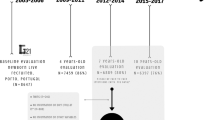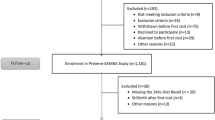Abstract
Objective:
To examine the stability of dietary patterns in young women over a two-year period and to identify factors that influence stability.
Design:
A food frequency questionnaire was used to assess diet. In a subgroup, this was repeated after 2 years. Questions were asked about major changes to diet over this time. Dietary patterns were identified using principal components analysis and pattern scores were compared at the two time points. The consumption of foods was also examined. The relationship between change in pattern scores and socio-demographic factors and body mass index was assessed.
Setting:
The Southampton Women's Survey, a prospective study of diet, health and lifestyle in young women and their influences on fetal growth
Subjects:
A subgroup of 94 women from a cohort of 6129 nonpregnant women aged 20–34 years.
Results:
Two dietary patterns, labelled ‘prudent’ and ‘high energy’, were identified. Spearman correlation coefficients between the initial and repeat scores for the prudent and high-energy patterns were 0.81 and 0.64, respectively. Average changes (repeat – initial) were 0.13 and −0.01 SD of initial score. Change in prudent dietary pattern score was influenced by amount of strenuous exercise taken and by changes in partnership status. An increase in high-energy pattern score was associated with lower social class.
Conclusions:
Dietary patterns in young women are reasonably stable over a 2-year period. This suggests that dietary patterns identified in the recent past may provide useful information about current dietary patterns.
Sponsorship:
The study was funded by the Dunhill Medical Trust, the University of Southampton and the Medical Research Council.
This is a preview of subscription content, access via your institution
Access options
Subscribe to this journal
Receive 12 print issues and online access
$259.00 per year
only $21.58 per issue
Buy this article
- Purchase on Springer Link
- Instant access to full article PDF
Prices may be subject to local taxes which are calculated during checkout

Similar content being viewed by others
References
Bertheke PG, de Vente W, Kemper HC, Twisk JW (2001). Longitudinal trends in and tracking of energy and nutrient intake over 20 years in a Dutch cohort of men and women between 13 and 33 years of age: The Amsterdam growth and health longitudinal study. Br J Nutr 85, 375–385.
Bland JM, Altman DG (1986). Statistical methods for assessing agreement between two methods of clinical measurement. Lancet 1, 307–310.
Byers T (2001). Food frequency dietary assessment: how bad is good enough? Am J Epidemiol 154, 1087–1088.
Crozier SR, Robinson SM, Borland SE, Inskip HM, SWS study group (2006). Dietary patterns in The Southampton Women's Survey. Eur J Clin Nutr 60, 1391–1399.
Fung TT, Willett WC, Stampfer MJ, Manson JE, Hu FB (2001). Dietary patterns and the risk of coronary heart disease in women. Arch Intern Med 161, 1857–1862.
Health Survey for England (2002). Health Survey for England 2002 – trends. Body Mass Index (BMI), by survey year, age and sex. http://www.dh.gov.uk/assetRoot/04/06/60/70/04066070.xl (accessed 15 Sept 2005), Internet.
Hu FB (2002). Dietary pattern analysis: a new direction in nutritional epidemiology. Curr Opin Lipidol 13, 3–9.
Hu FB, Rimm E, Smith-Warner SA, Feskanich D, Stampfer MJ, Ascherio A et al. (1999). Reproducibility and validity of dietary patterns assessed with a food-frequency questionnaire. Am J Clin Nutr 69, 243–249.
Inskip HM, Godfrey KM, Robinson SM, Law CM, Barker DJ, Cooper C (2006). Cohort profile: The Southampton Women's Survey. Int J Epidemiol 35, 42–48.
Joliffe IT, Morgan BJ (1992). Principal component analysis and exploratory factor analysis. Stat Methods Med Res 1, 69–95.
Khani BR, Ye W, Terry P, Wolk A (2004). Reproducibility and validity of major dietary patterns among Swedish women assessed with a food-frequency questionnaire. J Nutr 134, 1541–1545.
Lin LI (1989). A concordance correlation coefficient to evaluate reproducibility. Biometrics 45, 255–268.
Macdonald HM, New SA, Reid DM (2005). Longitudinal changes in dietary intake in Scottish women around the menopause: changes in dietary pattern result in minor changes in nutrient intake. Public Health Nutr 8, 409–416.
Osler M, Heitmann BL, Gerdes LU, Jorgensen LM, Schroll M (2001). Dietary patterns and mortality in Danish men and women: a prospective observational study. Br J Nutr 85, 219–225.
Prevost AT, Whichelow MJ, Cox BD (1997). Longitudinal dietary changes between 1984-5 and 1991-2 in British adults: association with socio-demographic, lifestyle and health factors. Br J Nutr 78, 873–888.
Robinson S, Godfrey K, Osmond C, Cox V, Barker D (1996). Evaluation of a food frequency questionnaire used to assess nutrient intakes in pregnant women. Eur J Clin Nutr 50, 302–308.
Robinson SM, Crozier SR, Borland SE, Hammond J, Barker DJ, Inskip HM (2004). Impact of educational attainment on the quality of young women's diets. Eur J Clin Nutr 58, 1174–1180.
Slattery ML, Boucher KM, Caan BJ, Potter JD, Ma KN (1998). Eating patterns and risk of colon cancer. Am J Epidemiol 148, 4–16.
Stata Corporation (2001). Stata Statistical Software: Release 7.0 Stata Corporation. College Station, TX..
Weismayer C, Anderson JG, Wolk A (2006). Changes in the stability of dietary patterns in a study of middle-aged Swedish women. J Nutr 136, 1582–1587.
Acknowledgements
We are very grateful to the General Practitioners of Southampton who made this study possible, the Southampton Women's Survey staff and particularly to the women of Southampton who took part. This work was funded by the Medical Research Council, the Dunhill Medical Trust and the University of Southampton.
Author information
Authors and Affiliations
Consortia
Corresponding author
Additional information
Guarantor: SE Borland.
Contributors: SMR, HMI and SEB were responsible for the study design. SEB co-ordinated this sub-study, whereas HMI co-ordinated the Southampton Women's Survey. SRC performed all statistical analyses. SMR and SEB processed the dietary data and drafted the manuscript. All authors contributed to the interpretation of the data and approved the final version.
Rights and permissions
About this article
Cite this article
Borland, S., Robinson, S., Crozier, S. et al. Stability of dietary patterns in young women over a 2-year period. Eur J Clin Nutr 62, 119–126 (2008). https://doi.org/10.1038/sj.ejcn.1602684
Received:
Revised:
Accepted:
Published:
Issue Date:
DOI: https://doi.org/10.1038/sj.ejcn.1602684
Keywords
This article is cited by
-
The key determinants of individual greenhouse gas emissions in Germany are mostly domain-specific
Communications Earth & Environment (2023)
-
Tracking of dietary patterns between pregnancy and 6 years post-pregnancy in a multiethnic Asian cohort: the Growing Up in Singapore Towards healthy Outcomes (GUSTO) study
European Journal of Nutrition (2022)
-
Midlife susceptibility to the effects of poor diet on diabetes risk
European Journal of Clinical Nutrition (2021)
-
Dietary seaweed intake and depressive symptoms in Japanese adults: a prospective cohort study
Nutrition Journal (2019)
-
Longitudinal changes in the dietary inflammatory index: an assessment of the inflammatory potential of diet over time in postmenopausal women
European Journal of Clinical Nutrition (2016)



